So You Want to Build Water Leakage Detection Software? Read This First

Are you a homeowner trying to protect your home from water leaks? Or the head of a department struggling to maximize the efficiency of your water supply systems? Or any other professional who wants to find the hidden water leaks in your property? You definitely need a smart IoT-based water leak detection system in all the above cases.
Believe it or not, IoT technology has advanced so far that it can handle water leaks detection easily. IoT systems either alert you to a water leakage problem in real-time or fix it automatically, so you won’t even notice it. Sounds promising?
Read our article about the benefits and features of smart water leak detection systems and how they can simplify and automate leak detection with up to 75% accuracy. This guide will also provide the basics on water leakage software development if you consider building such as solution with the help of an IoT development firm.
The state of the smart leak detection market
According to McKinsey estimations, the potential impact of the Internet of Things as a combined business opportunity of $11 trillion over the next ten years – equivalent to roughly 11% of the global economy. And these capabilities extend to smart city solutions, which are in great demand in today’s market. Control over water resources has also become one segment of increased interest.
Freshwater is an asset for human survival that requires constant real-time monitoring to supply as needed efficiently. Rapid urbanization combined with climate change has significantly affected water availability to meet growing urban demand. The physical loss of water because of leaking pipelines has become a key factor in the emergence of the so-called NRW – water that does not bring income.
That is the water that is lost before it reaches the end-users. Plumbing pipelines periodically lose an average of 20% to 30% of the water transported through them. These numbers can rise to over 50% in older systems, especially those that suffer from inefficient maintenance. The world’s NRW is estimated at 126 billion liters per year, about $40 billion per year in monetary terms.

The need for optimal distribution of water resources and the desire to reduce high production costs have stimulated the demand for intelligent solutions to prevent water losses because of such common problems as leaks, miscalculations, and interventions.
IoT for water management
Intelligent technology can transform conventional water and wastewater systems into automated, interconnected, intelligent systems.
- Instrumented – to detect, sense, measure, and record data.
- Interconnected – to communicate and interact with system operators and managers.
- Intelligent – to analyze the situation, enable quick responses, and optimize troubleshooting in water management systems.
Intelligent systems can provide accurate and up-to-date information that enables water managers to make informed and systematic decisions instead of one-off. They can automate tasks and reduce the need to hire additional staff. Analysts predict that these benefits will drive the smart water management market to $18.9 billion in 2028.
Nowadays, most utilities have installed smart meters to measure their water consumption, vital for proper billing. That helps reduce the volume of NRW. But there are few or almost no data collection sensors between smart meters and water pumps.
That highlights the need for digital monitoring of the distribution network using sensors and allows utilities, entrepreneurs, and individual users to base their actions on knowledge rather than guess and assumptions.
The installation of digital sensors at strategic points in the network allows utilities to understand where they should focus their efforts on repairing leaks and which parts of the water supply network are not performing as efficiently as they should. Besides ensuring accuracy, this technology eliminates many routine procedures that people previously served manually.
According to market research firm StrategyHelix, the global smart water leak detection market will grow by $1 billion over 2021-2027, with a CAGR of 10.7% over the forecast period. To capitalize on this growth prospect, leak detection vendors must leverage investments in smart cities and resilient infrastructure and quickly deploy new technologies by customizing services to meet customer needs.

What is a leak detection system, and how does it work?
Modern leak detection systems are complete solutions with comprehensive services that provide significant benefits to users. They usually combine all the latest hardware and software to ensure efficient operation. In addition, they use cloud data storage for proper data management and advanced analytics algorithms that help ensure efficient data processing for better results.
Leak detection systems are programmable, which allows you to customize shutdown settings based on the water used in your home or business. They can connect to smartphones via the app and send alerts to detect leaks or irregular water flow.
The Bluetooth or Wi-Fi connectivity of most leak detection systems allows you to monitor water consumption in real-time. The detectors will notify you via the app when a leak has occurred, shutting off the water flow before a small leak turns into a disaster.
Advanced leak detection systems are equipped with intelligent valves that immediately stop the water flow. And real-time tracking provides helpful information about your home’s water use. Many leak detectors store both live and historical data visible in the application. Using this data, you can monitor water consumption and determine which appliances or devices are causing excess water consumption.
Features of the IoT-based water leakage detection system
Modern water leakage detection systems are automated and customized solutions equipped with the latest technology. Good water leakage software usually includes the following features:
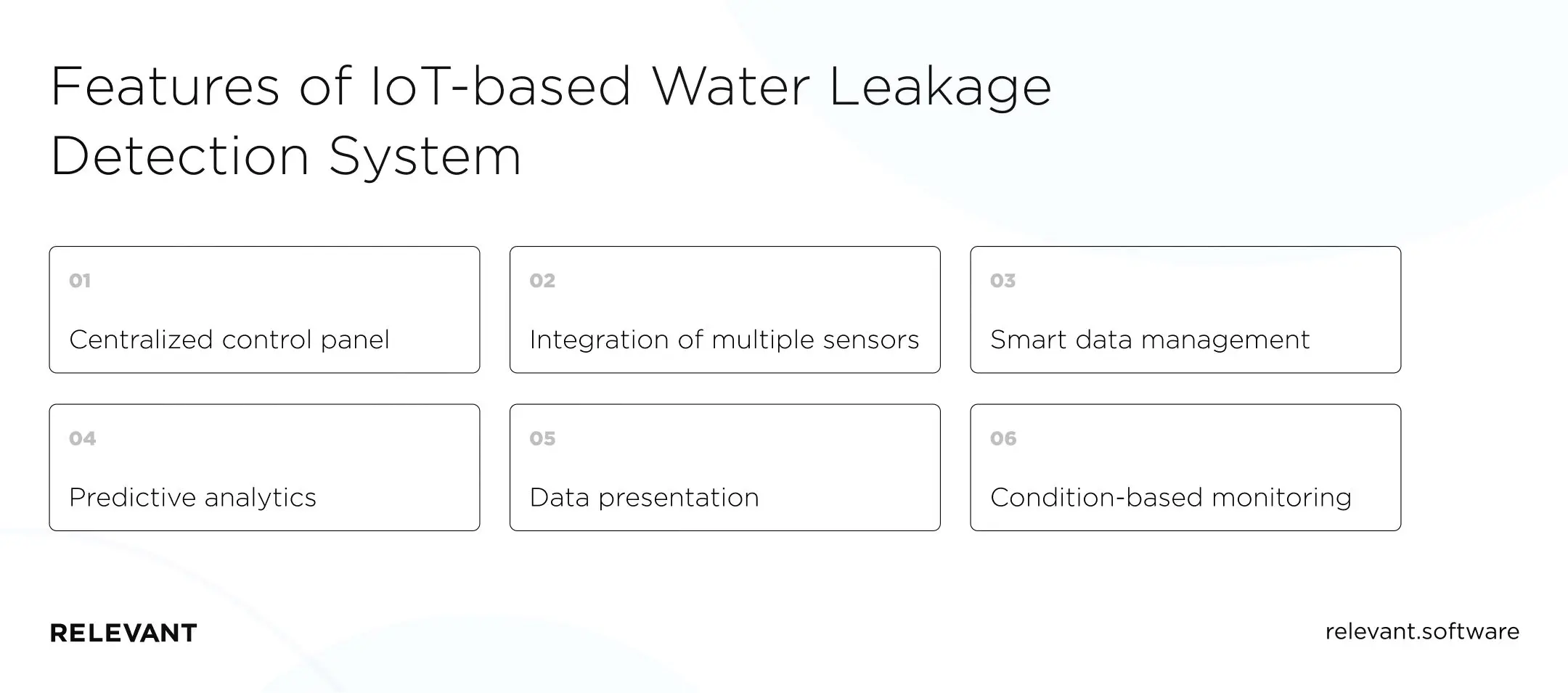
Centralized control panel
A single dashboard provides everything you need to manage and monitor leaked sites. With centralized control, the user can access the touch device from anywhere through their smart gadget.
Integration of multiple sensors
The water monitoring system IoT can take advantage of the capabilities of different sensors, such as zone leak detection and pinpoint leak detection. You can integrate any of these types based on your needs.
Smart data management
The smart water leak detection solution includes advanced sensors and gateways connected via a cloud-based data management platform. Plus, it offers informative reports to make more informed decisions about areas of the leak.
Predictive analytics
The IoT water leak detection solution can be equipped with intelligent algorithms to analyze and monitor the condition of leaking areas in real-time. That leads to more intelligent management through ad hoc outcomes.
Data presentation
The IoT solution is packed with advanced features and visual reports to get accurate information and make effective decisions.
Condition-based monitoring
By integrating a water leak detection system, the platform can monitor the situation depending on the changing weather. For example, combining the sensory system provides insight into areas affected during the rainy season.
Here is a diagram of a high-level system architecture for a solution:
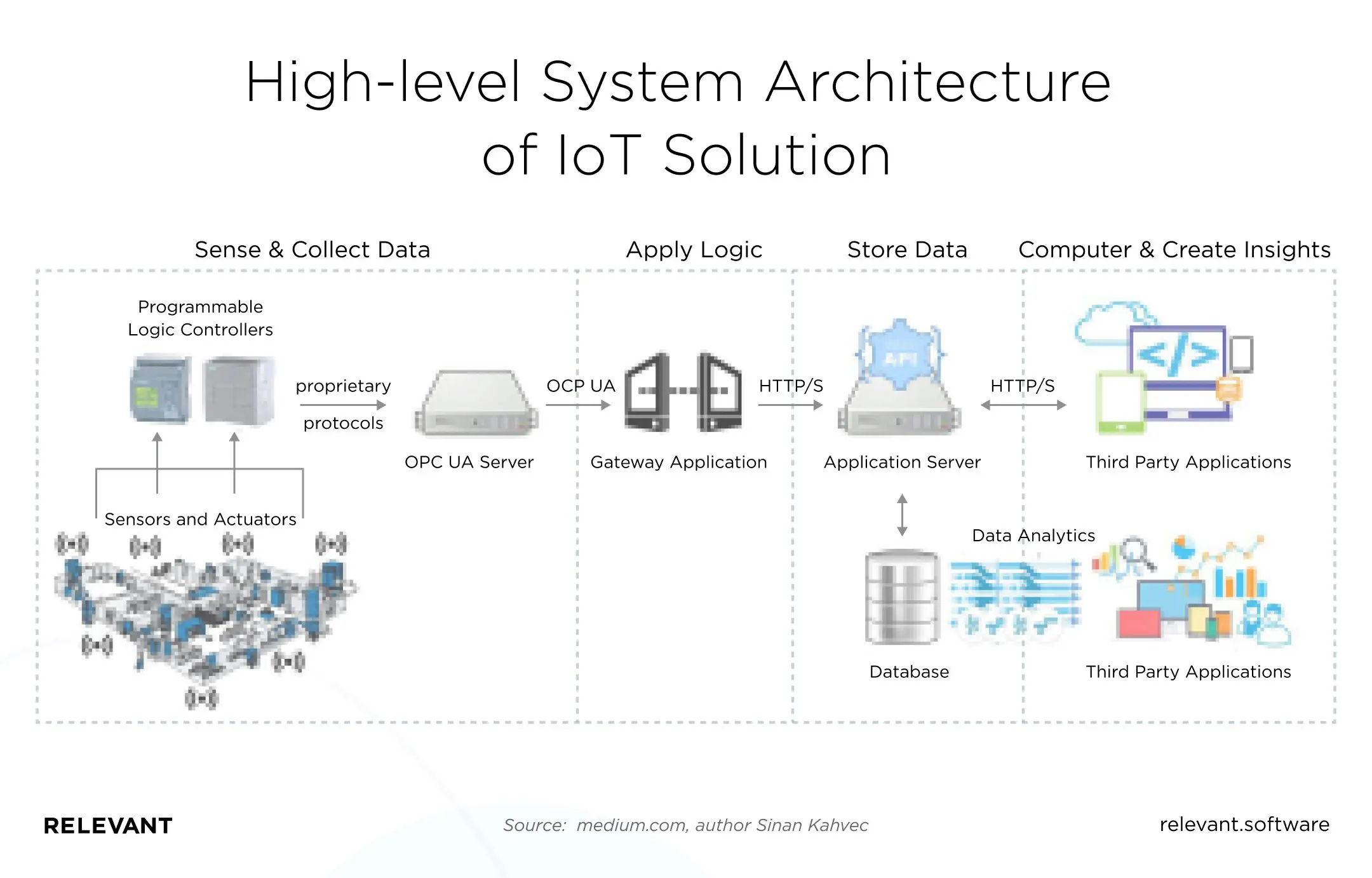
The advantages of using an IoT-powered water leakage detection solution
Water leak finder is a problem in most industries, and IoT technology is ideal. It provides safety, reduces maintenance costs, prevents water damage, and reduces water consumption. Using technology-based flood and leak detection techniques offers automated operations that advance high-tech features in the industry.
Advanced analytics and real-time alerts
The advanced analytical capabilities of IoT devices play a significant role in analyzing parameters such as water flow, temperature, humidity, and pressure. IoT big data solutions, combined with IoT sensors, help save data, perform analysis and generate valuable insights.
Real-time alerts and notifications for the user of water leaks guarantee the complete safety of the territory. Users can receive phone or other device alerts through the control panel or app. The real-time capabilities of the touch devices are so fast that as soon as water touches the floor, you are already notified to take action and prevent potential damage.
Construction safety
Sometimes water collects in hard-to-reach places and begins its destructive effect on nearby structures. That leads to the deterioration of infrastructure and degrades building materials’ quality.
However, IoT-powered solutions are equipped with first-class sensor devices and gateways to deliver the highest quality services. They include real-time detection of water leaks using point or zone leak detection techniques to protect buildings and utilities from water damage.
Preventive maintenance
IoT sensors deliver actual results using advanced algorithms embedded in IoT solutions. These decisions contribute to making informed decisions by predicting the future possibility of water leaks in factories. Preventive maintenance can lead to stringent industrial precautions, which will prevent colossal water losses and damage to machines and goods.
Reduced costs
IoT technologies are currently widely used in various industries. Their integration with water supply systems provides an additional advantage for the entire treatment of the water supply network. It offers significant cost savings as the technology uses sensor devices and gateway connectivity to meet maintenance schedules on time and reduce process downtime.

Examples of innovative approaches to reducing leakage
To eliminate leaks, water companies are introducing various latest technologies and developing skills and competencies in all areas of detection, containment, and repair. Smart grids, advanced sensors, satellite technology, and drones are all part of an arsenal used to detect and repair leaks faster than ever and at a lower cost.
SES Water
SES Water has teamed up with Vodafone technology to create an intelligent water distribution network that aims to reduce leaks by 15% over the next five years and pave the way for more than half of leaks by 2045.
Сompany is installing water meters, sensors, and acoustic loggers in underground pipelines. Data will be collected and transmitted through the system. It will use advanced analytics to track readings and alert SES Water immediately in the event of a leak, low pressure, or another network failure.
Northumbrian Water
Essex & Suffolk Water (part of Northumbrian Water) has joined satellite specialists Utilis and energy giant SUEZ to use the capabilities of space satellites to detect leaks in its network. Using the same technology that helps find water on other planets, satellites are being used to detect leaks and unusual water deposits. This data will then be passed on to a field team of leak repair technicians to investigate further.
Affinity Water
Finding leaks on plastic pipes has been a problem in the water sector for years. Traditional leak detection methods used on metal pipes are not suitable for plastic pipes because the sound produced by the leak is virtually silent. That is why Affinity Water uses state-of-the-art high-frequency correlators from Engima and Gutermann, which enable engineers to find pipe leakage faster, with greater accuracy and efficiency, especially on plastic pipes.
How to develop water leakage detection software?
An intelligent water leakage solution is a high-tech system that prevents water-related incidents. The entire solution is merged on a single platform and uses an application form to perform remote operations and customize it as required. In addition, universal mobile IoT apps make it easy to manage through any connected dashboards, such as iOS or Android.
Developing an IoT Solution: 5 Steps
The product development stages are the same for any IoT project, and water leakage detection solution development is no exception.
Business case development
The first step is to identify short-term and long-term business goals and plan a value proposition. Will your product be an end-to-end solution (which includes everything from hardware to software and networks) or just a platform to connect? The customer service form will be determined by where your use case and business model intersect.
Build vs. Buy and vendor evaluation
After defining your business goals, you need to decide: should you create the solution yourself or look for an external partner? In-house development is costly and complex, so outsourcing your project to a third party is the best bet.
The dedicated development team will select the right platform and tools for you, develop software to manage and centralize every aspect of the IoT network and connected devices, and take over the maintenance and upgrades of the solution in the future. You will not need to hire and train your specialists, which will reduce development costs.
Proof of concept
Prototyping an IoT network on a small scale is necessary for successfully implementing a smart water leak detection solution. The prototype should focus on its benefits to customers, not the features that can help sell your product. Prototype assessment will help improve the application architecture, assess risks and choose an approach to mitigate them.
Initial pilot rollout
After confirming the prototype, a team should perform a test run of the system to ensure that it works and that the full deployment is worth it. The most important takeaway from this phase is that the workflow, convenience, or cost savings are tangible enough to justify a full deployment of the technology.
Commercial deployment
When the IoT solution is deployed to thousands of devices, the system’s security, manageability, and scalability become essential to overall success. Many scenarios require a mix of cloud and edge / on-premises deployments to find the right balance between scale, cost, latency, and data privacy. So make sure your connected system can support hybrid workflows and seamlessly migrate from the edge to the cloud.
Containerized applications succeed in the DevOps world due to their modular, resource-efficient, and platform-agnostic nature. That makes them a perfect fit for a hybrid IoT architecture. So you can deploy individual service containers independently in any computing environment – an edge gateway, an on-prem server, or a cloud platform. Plus, leveraging modern container orchestration tools like Kubernetes, you can easily deploy, manage and scale the software to adapt to changing needs.
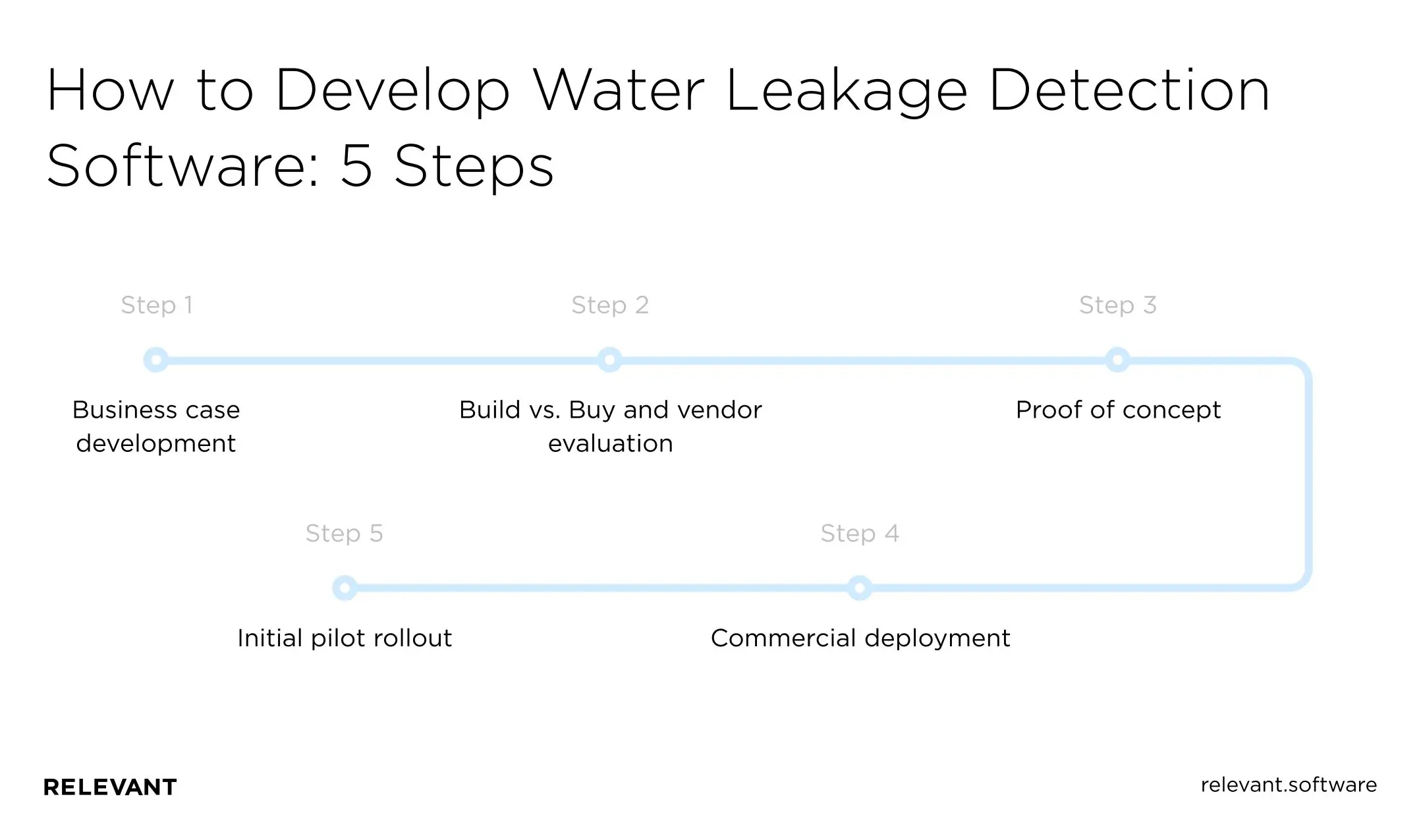
How we redesigned and developed a moisture monitoring platform
Dive into one of our latest software development cases for the IoT system.
Challenges
Sensor Innovation turned to us to improve the existing system of informing users about problems (including water leaks) in industrial and residential buildings. The design combined smart sensors and cloud technologies to control humidity in buildings. Still, it lacked an intuitive user interface and more efficient operation functionality, including displaying data directly on a virtual building drawing.
Features of the platform
Our product manager and UI/UX designer, two back-end developers, and two front-end developers redesigned the platform and added missing features.
- Dashboard. An intuitive dashboard gives customers a quick overview of their sensors, messages, alarms, and warnings. Service companies can also use this panel to manage the status of messages.
- Construction map. The customizable building map allows users to create a virtual representation of the location of the sensors and shows the status of each sensor. The system sends a corresponding notification if the situation changes because of external influences.
- Installations. The platform now provides an interactive process for adding, moving, replacing, or removing a new sensor or gateway.
- User roles. Sensor Innovation maintains a complete hierarchy of users in the application: the super administrator controls the service companies, managing the properties owned by the clients.
- Weather panel. The weather can indirectly affect the sensors, and we had to consider this. Users can now check sensor reports with historical weather data on the list page to keep the data up to date.
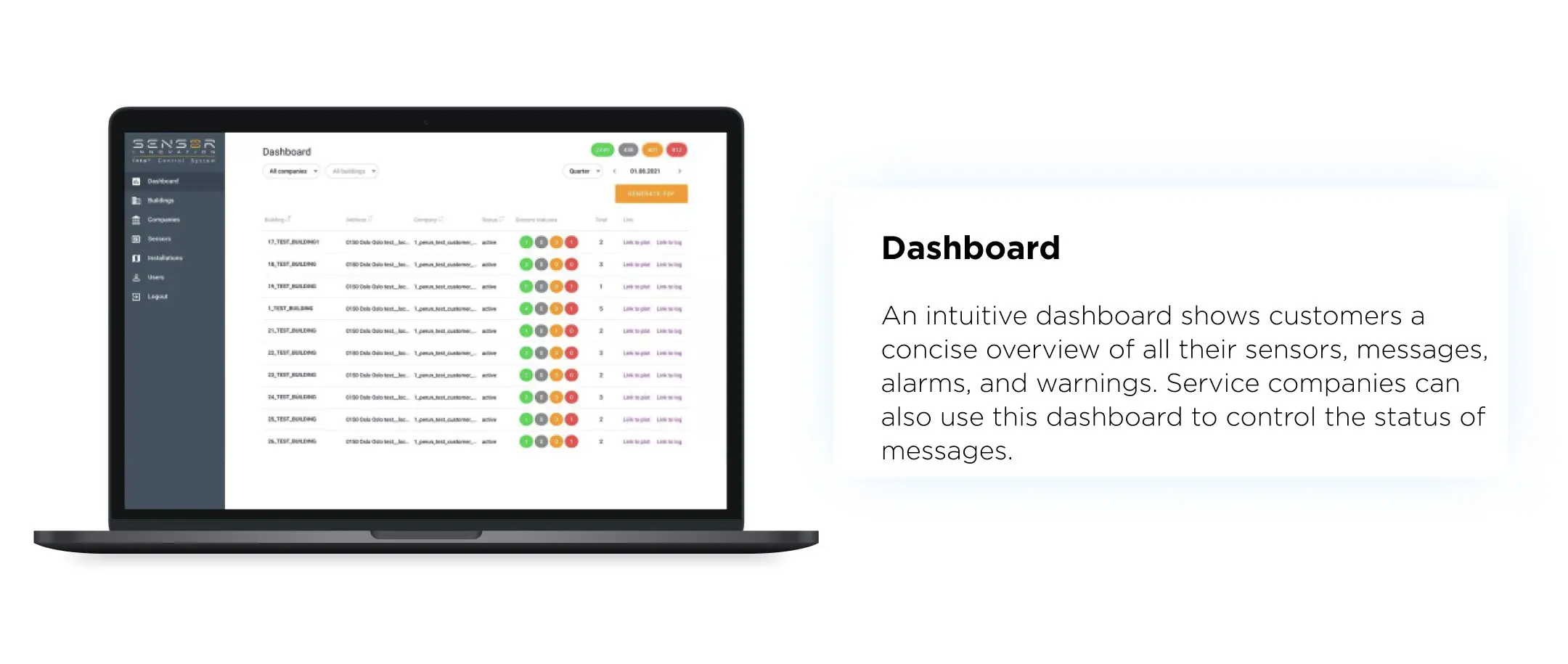

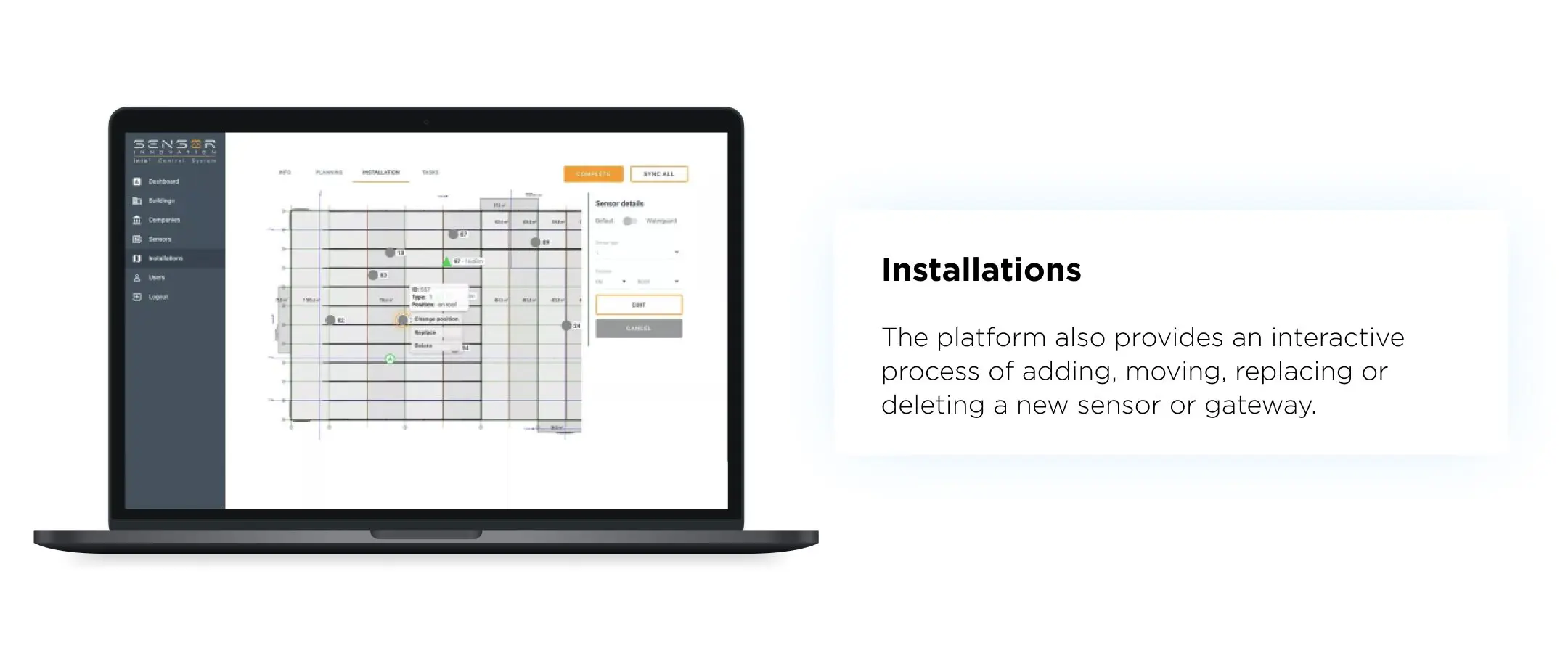
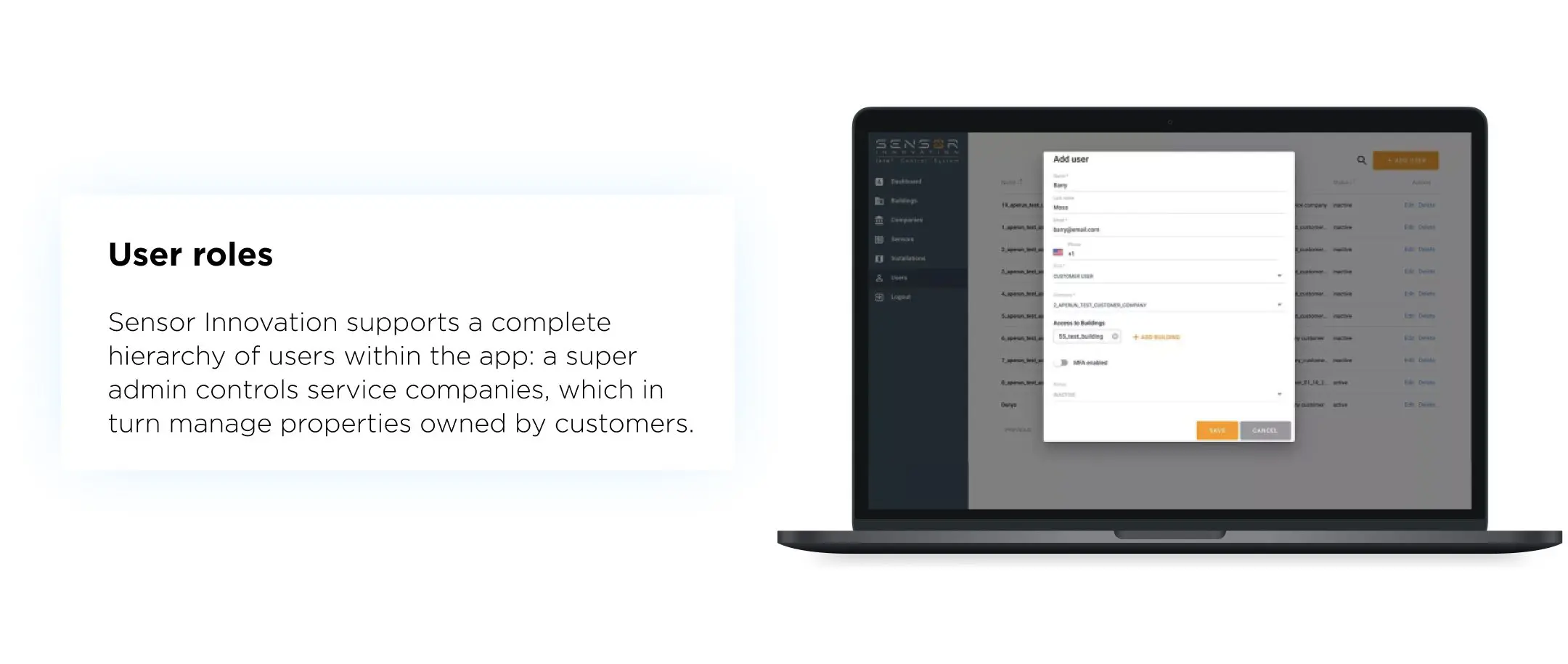

Technologies we worked with
To improve the platform, our experienced engineers have used tools such as React, Node.js, Express.js, MySQL, AWS, Docker, and TypeScript.
Result
Sensor Innovation has received an updated online platform that outperforms its predecessor in every way, from an optimized user interface and performance to advanced features. The addition of a weather timeline reduced false positives, and virtual building maps helped optimize coverage and find possible blind spots.
Conclusion
Are you exploring the possibility of using the Internet of Things to manage water resources or plan to hire a software development team to build water leakage detection software? We’re here to help.
Relevant Software is a company with hands-on experience developing IoT software solutions using various Internet of Things (AWS/Azure) platforms. By outsourcing your project to Relevant, you will access our best engineering talents to build custom IoT solutions that meet the most challenging technical requirements.
We are always looking for fresh approaches or technologies to provide better results, effectiveness, and safety. With us, you will receive a tangible competitive advantage that will help you beat your competitors.



